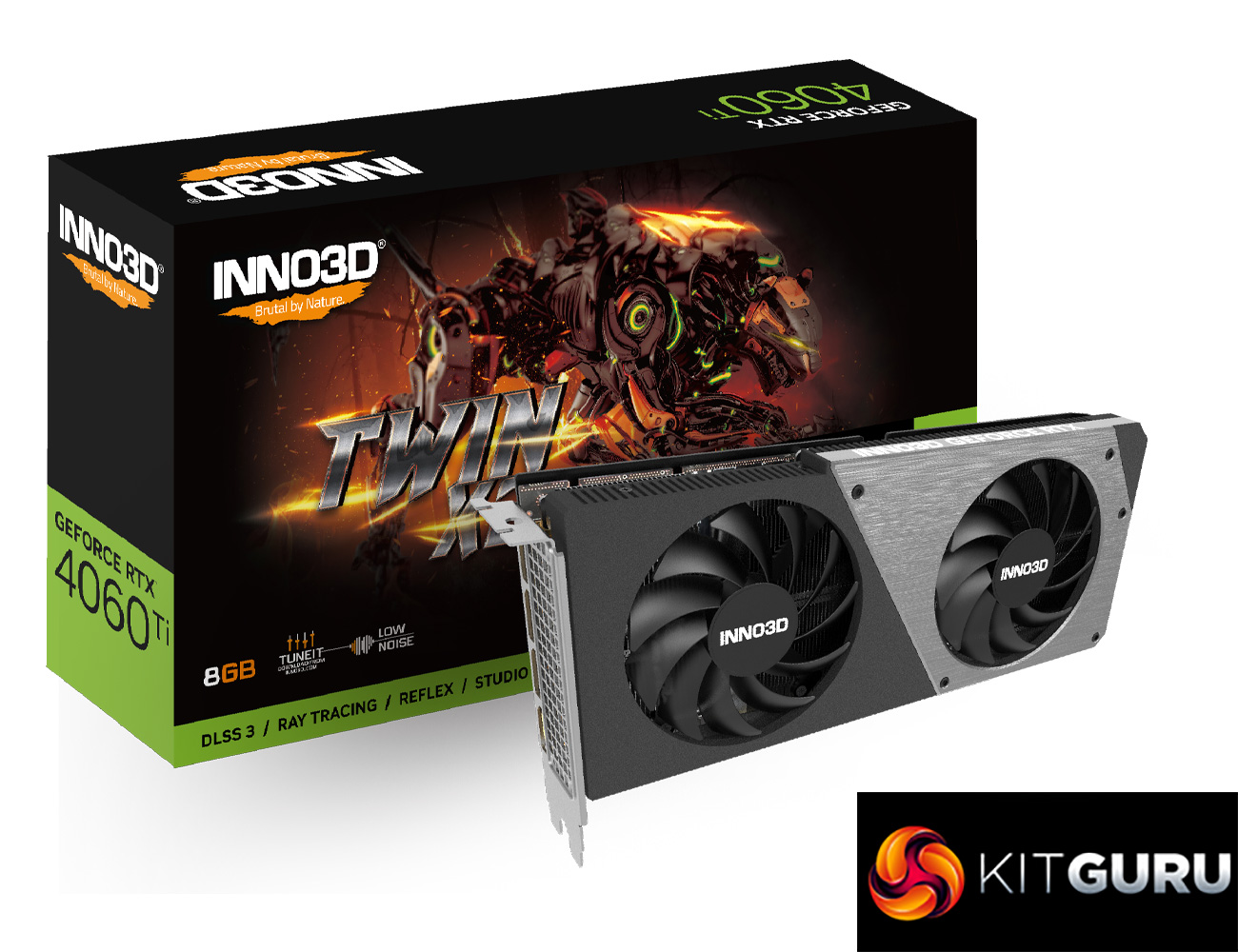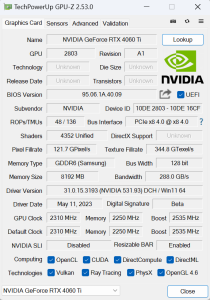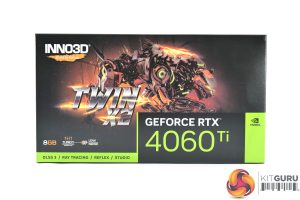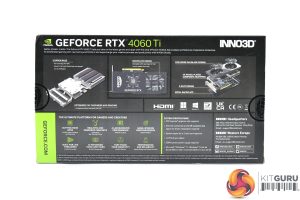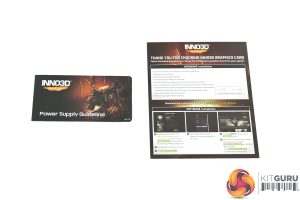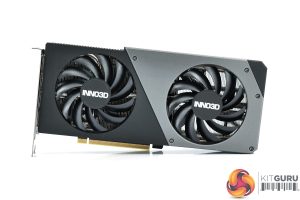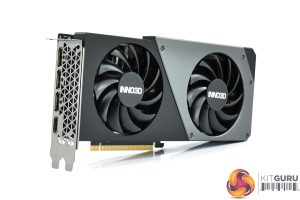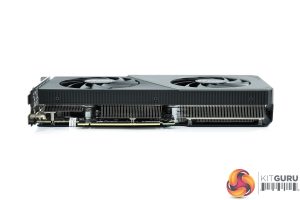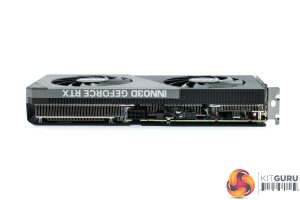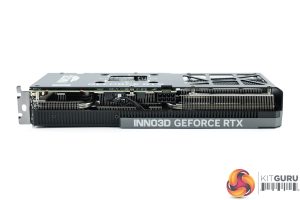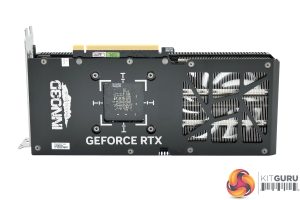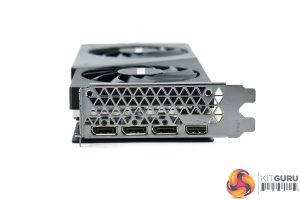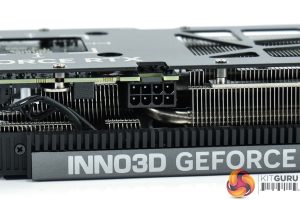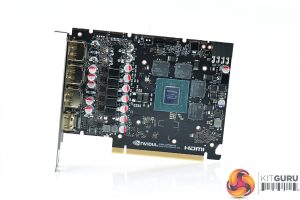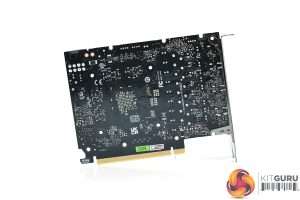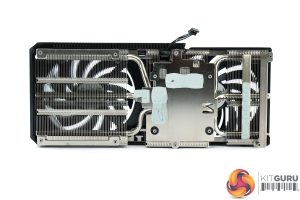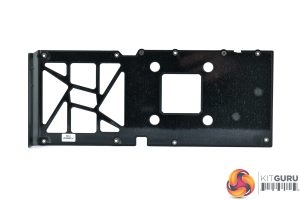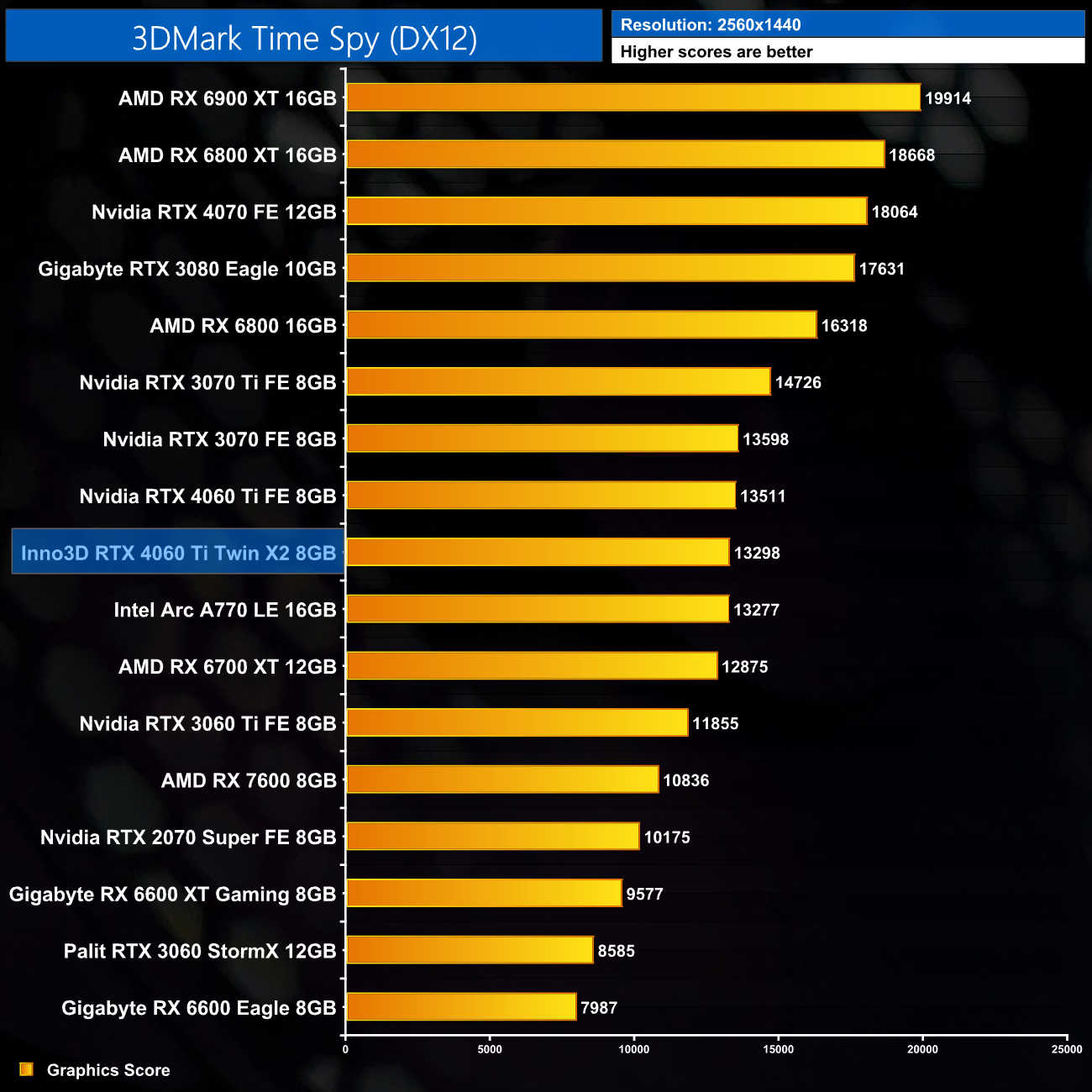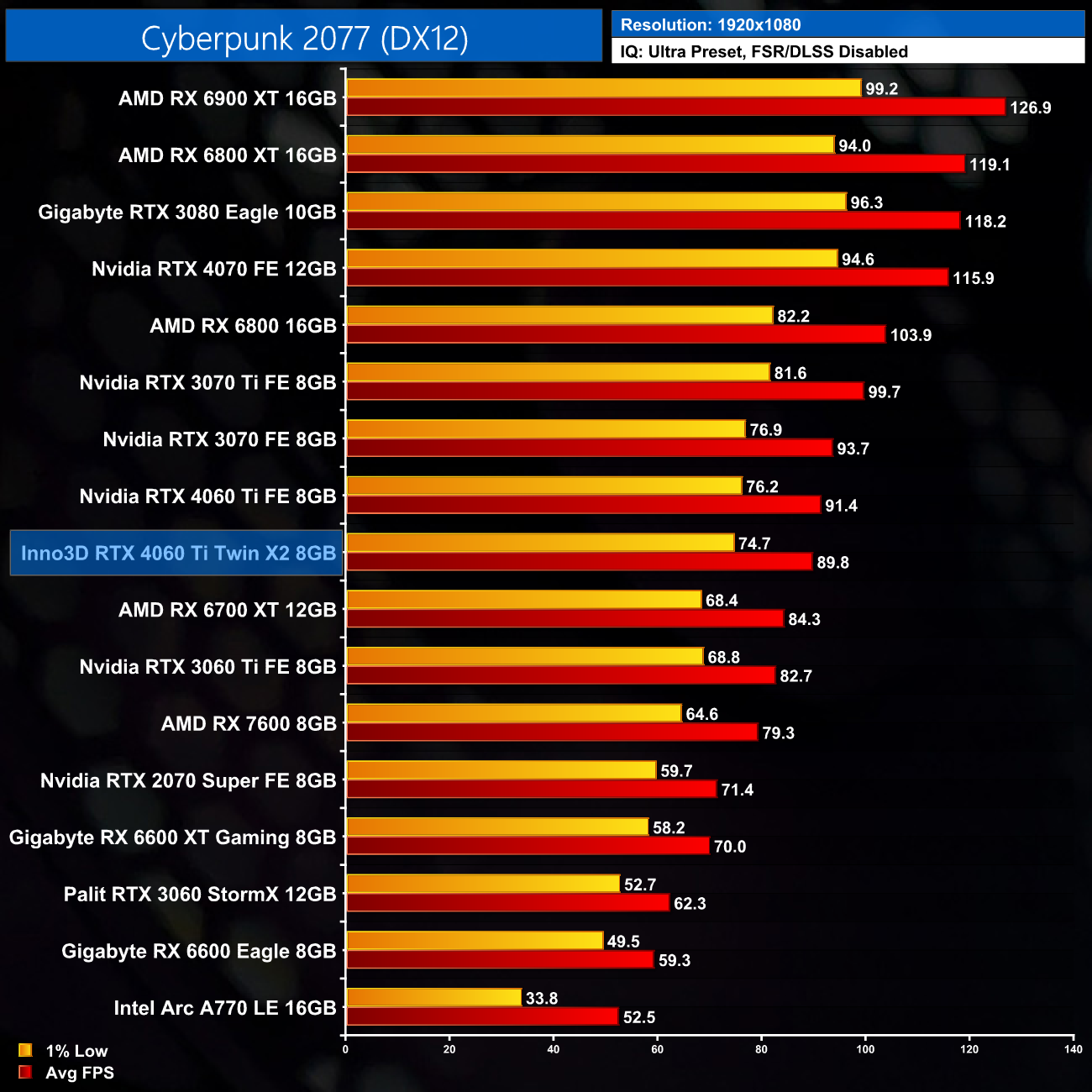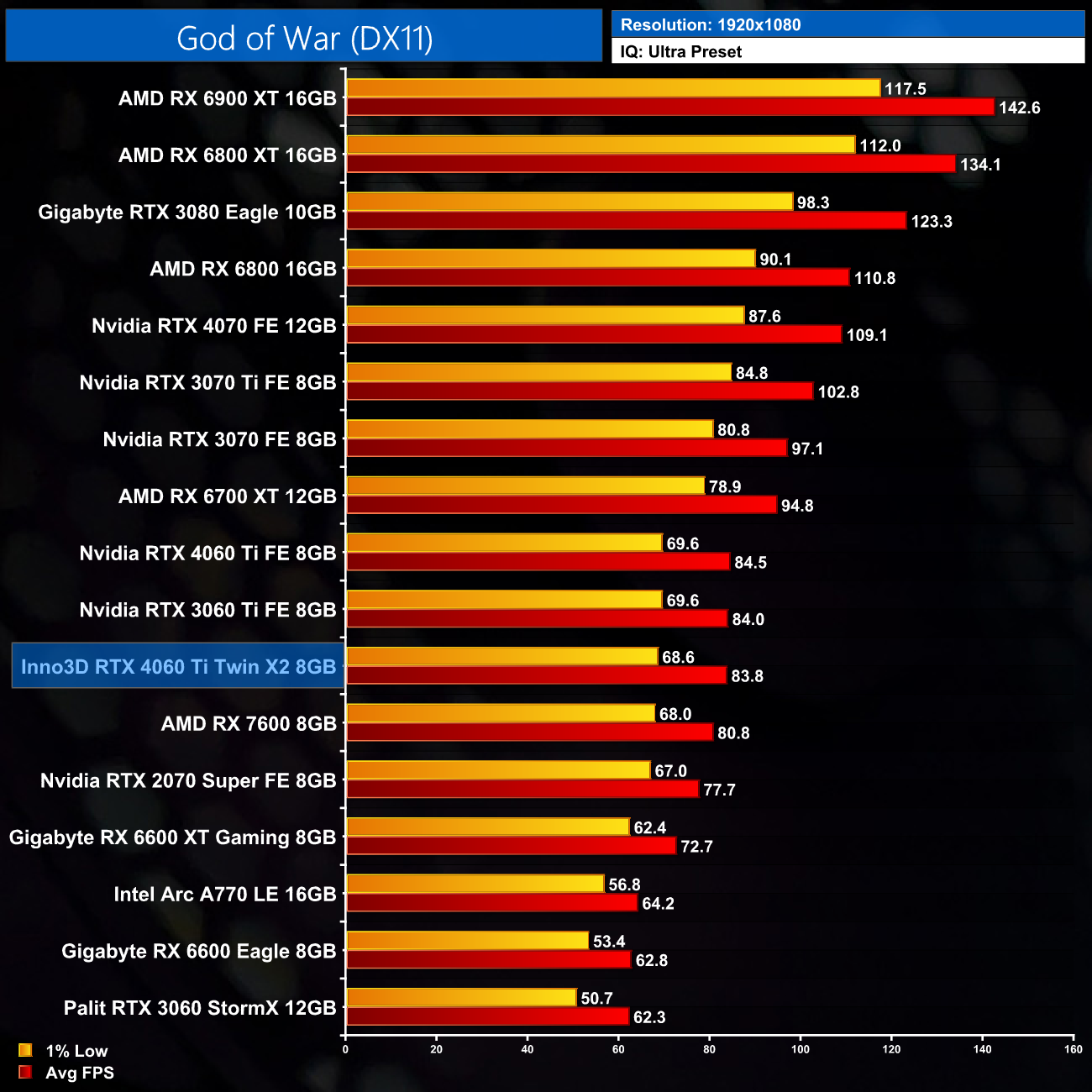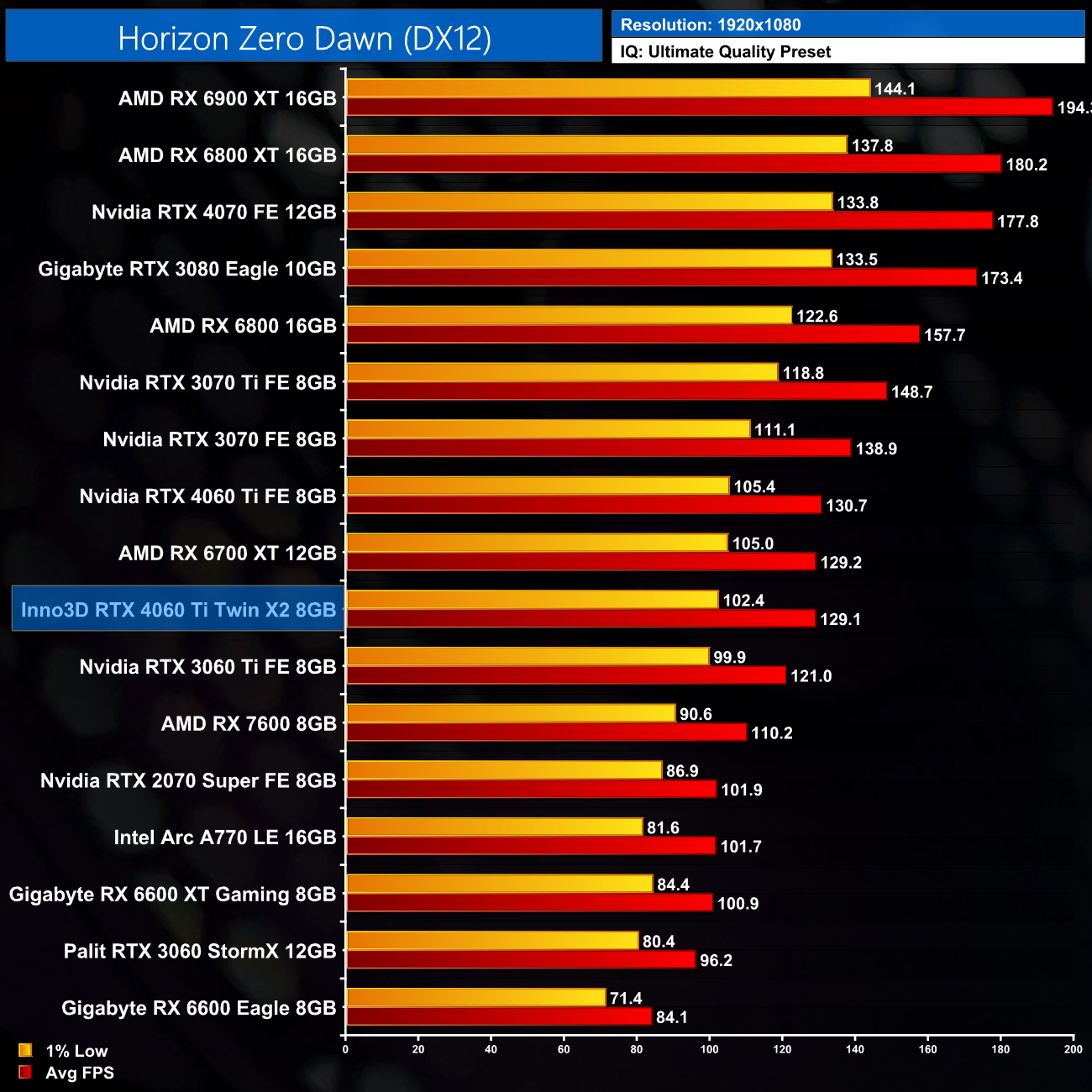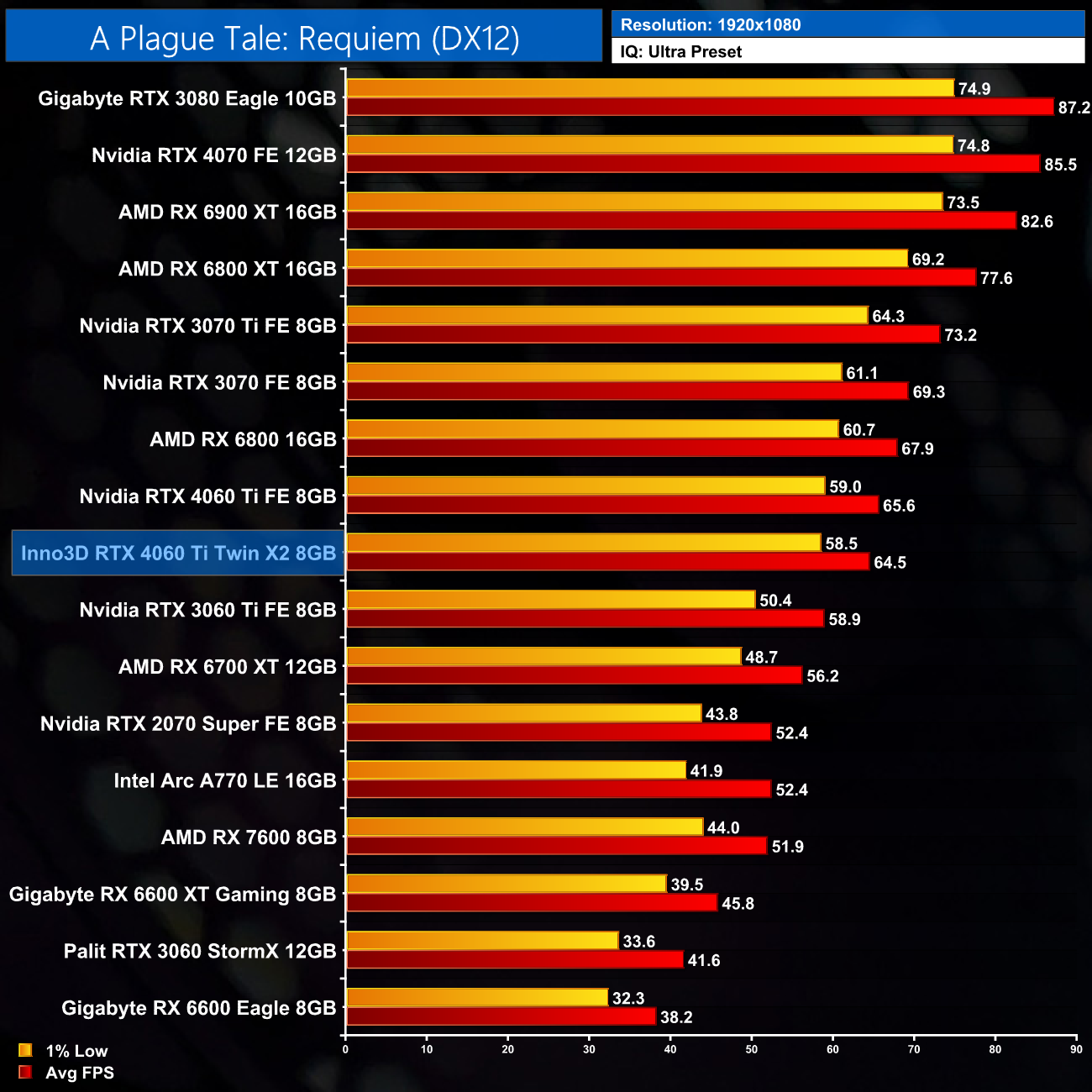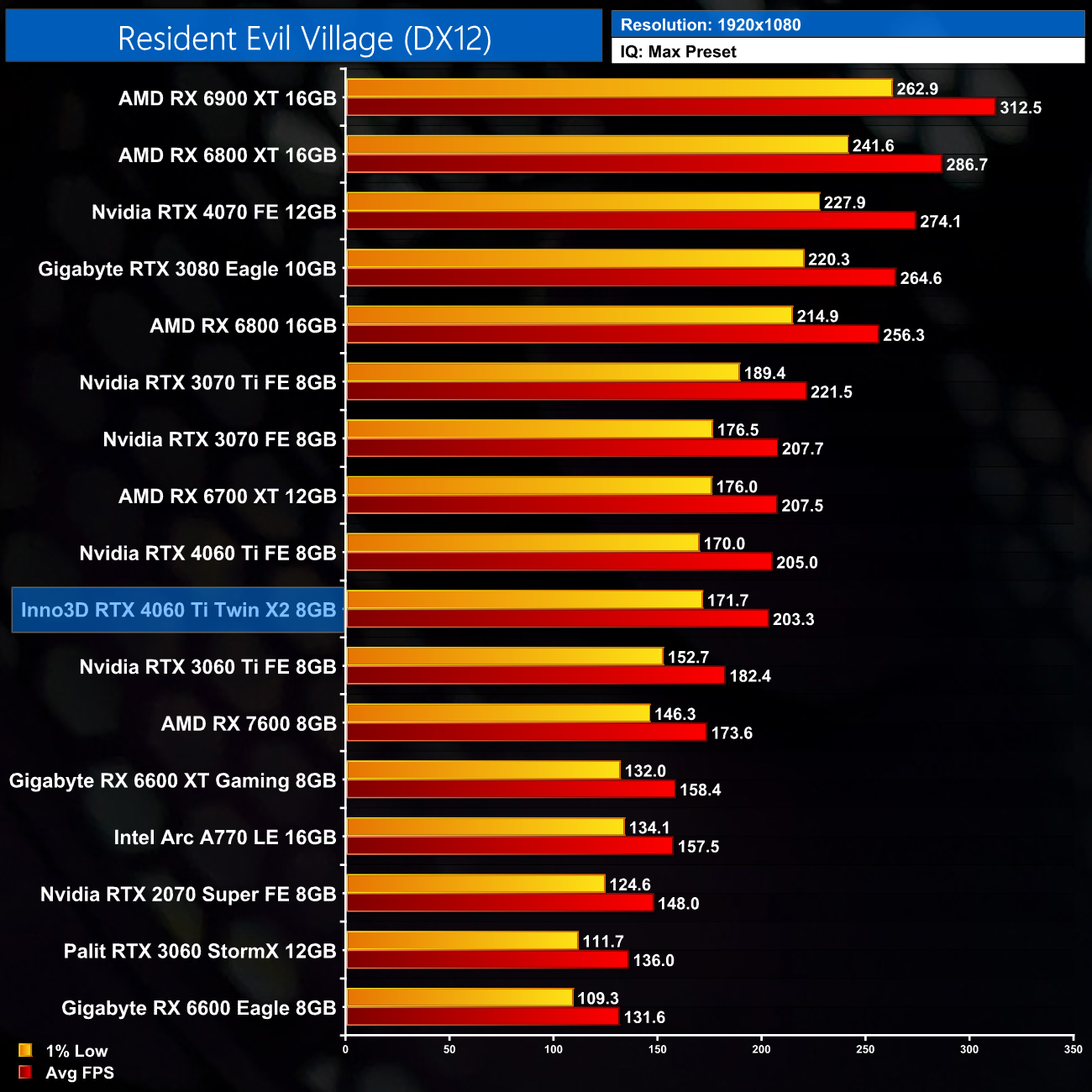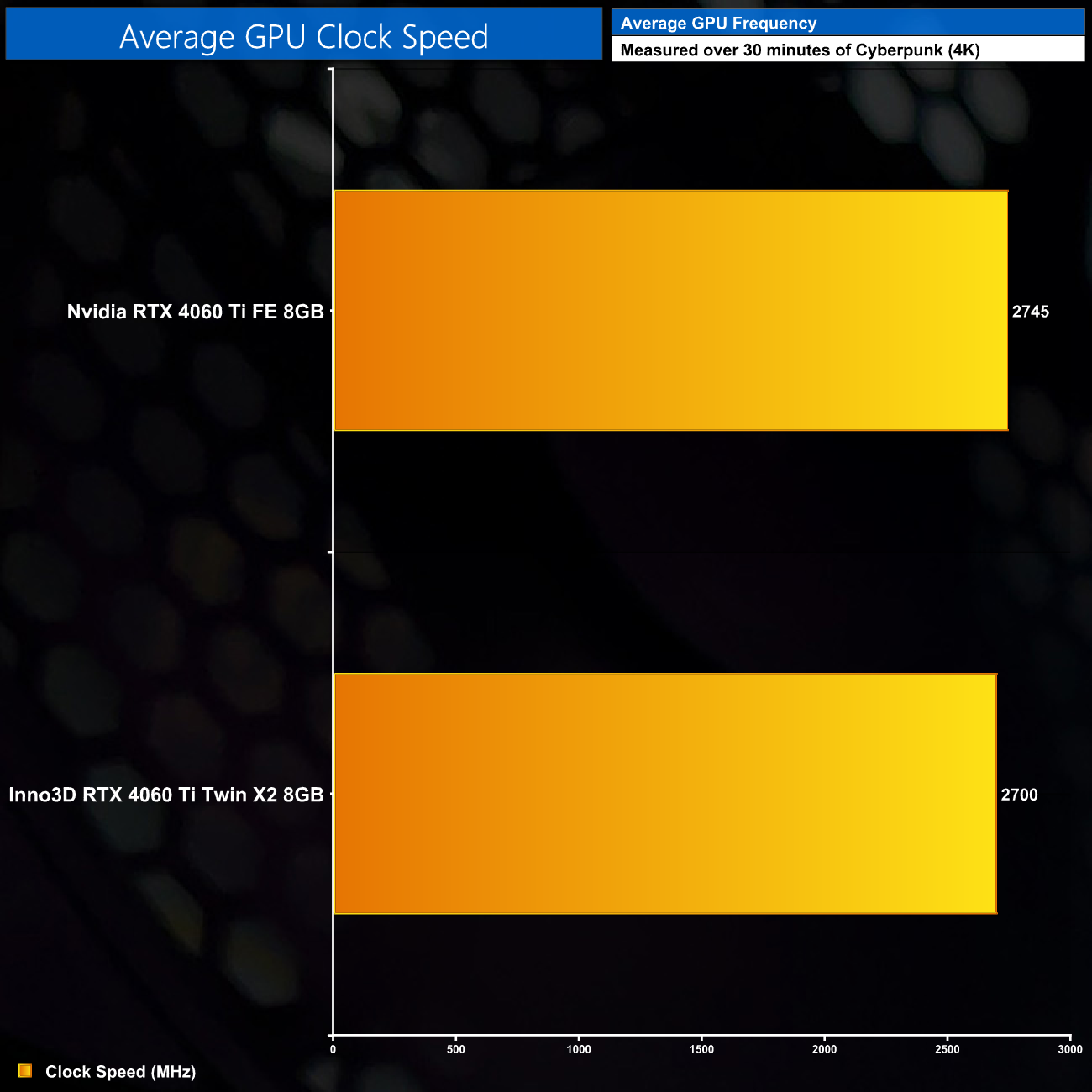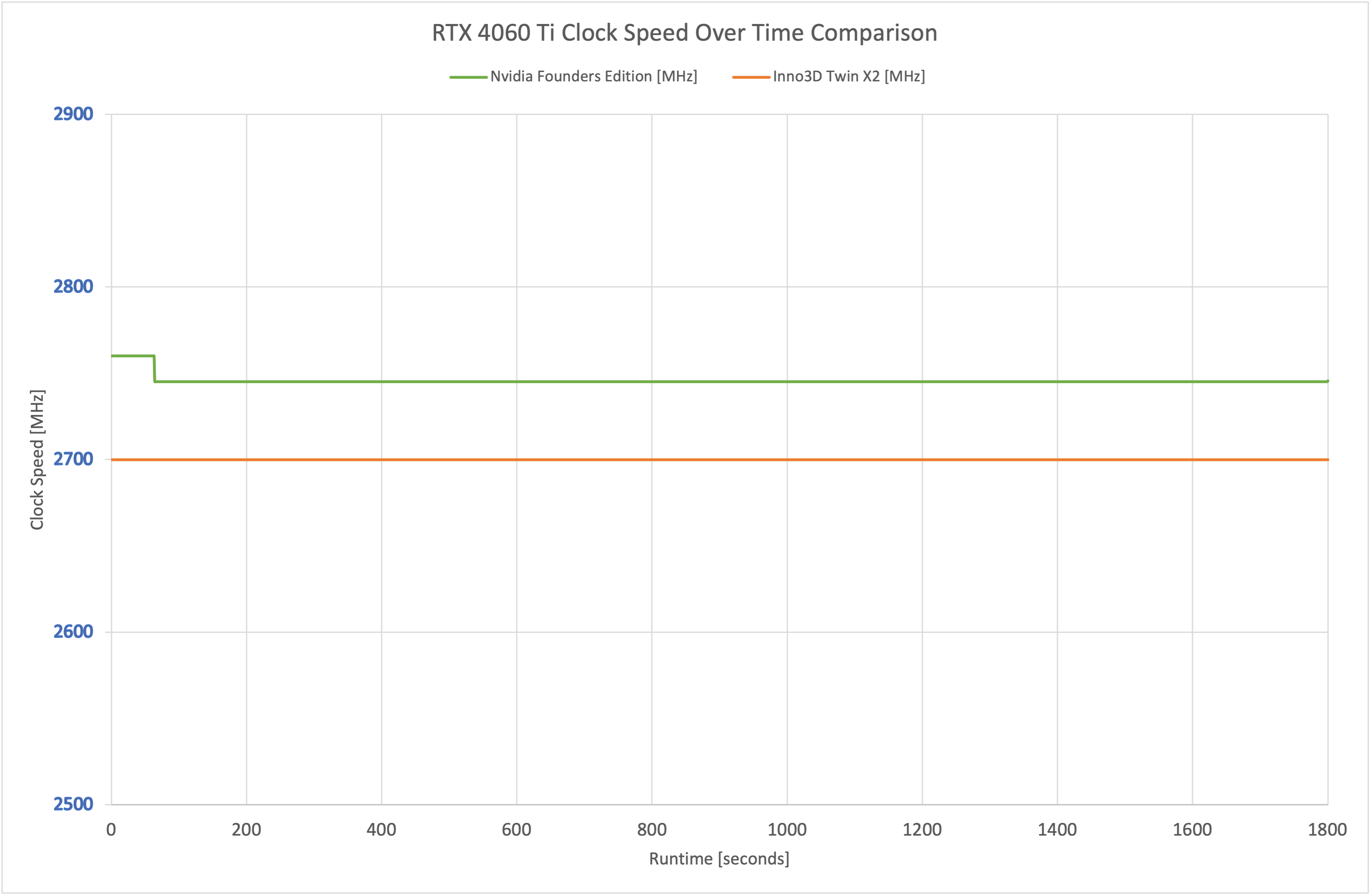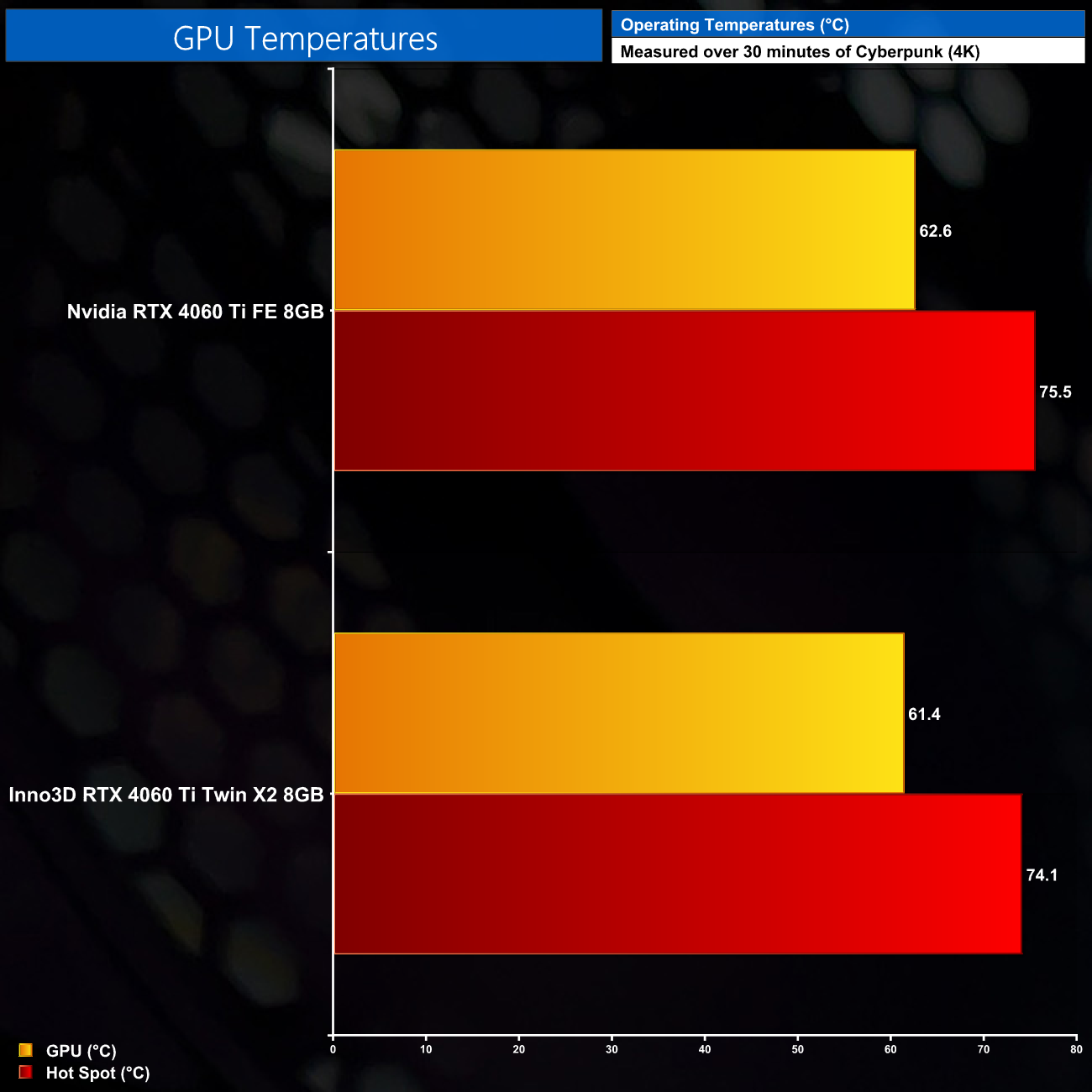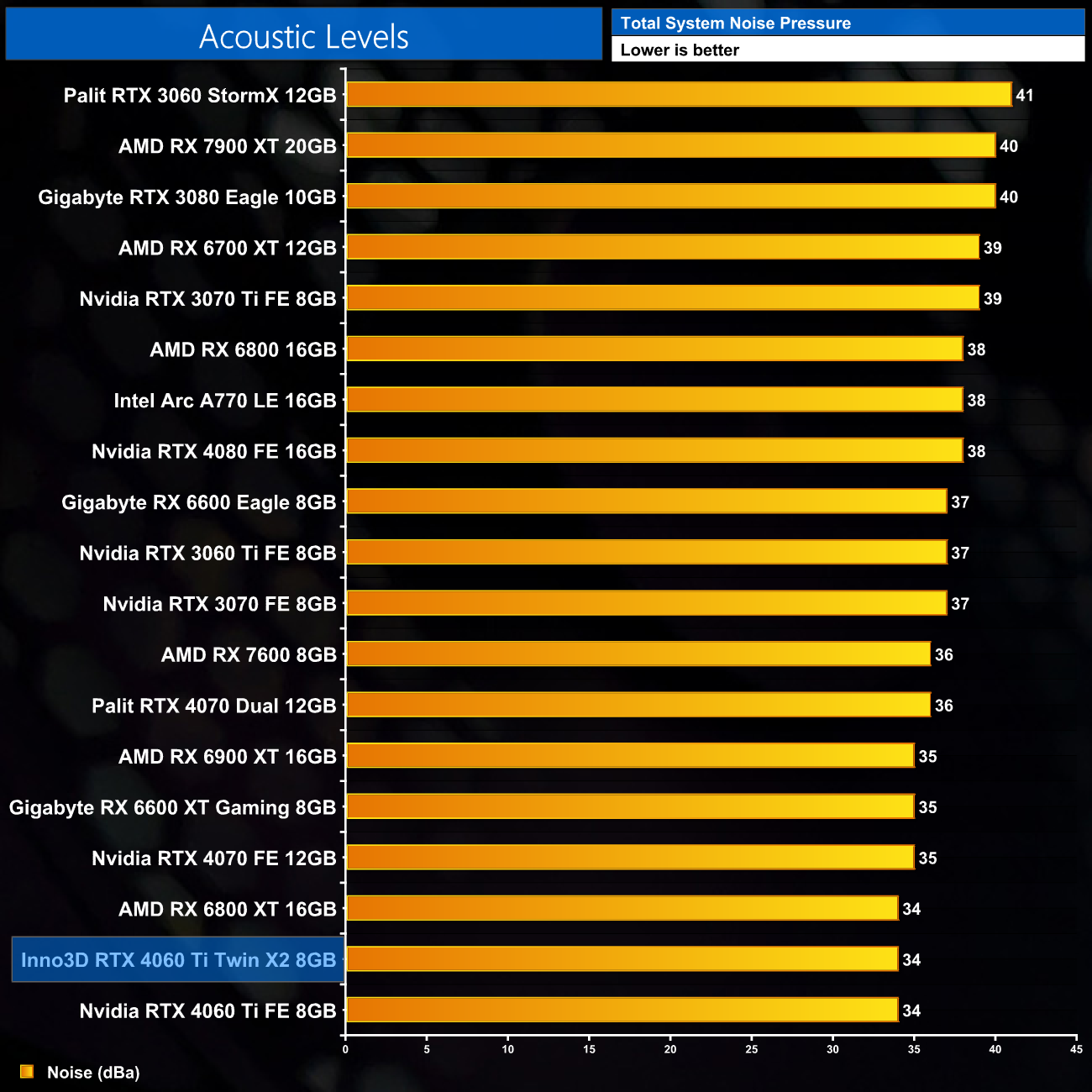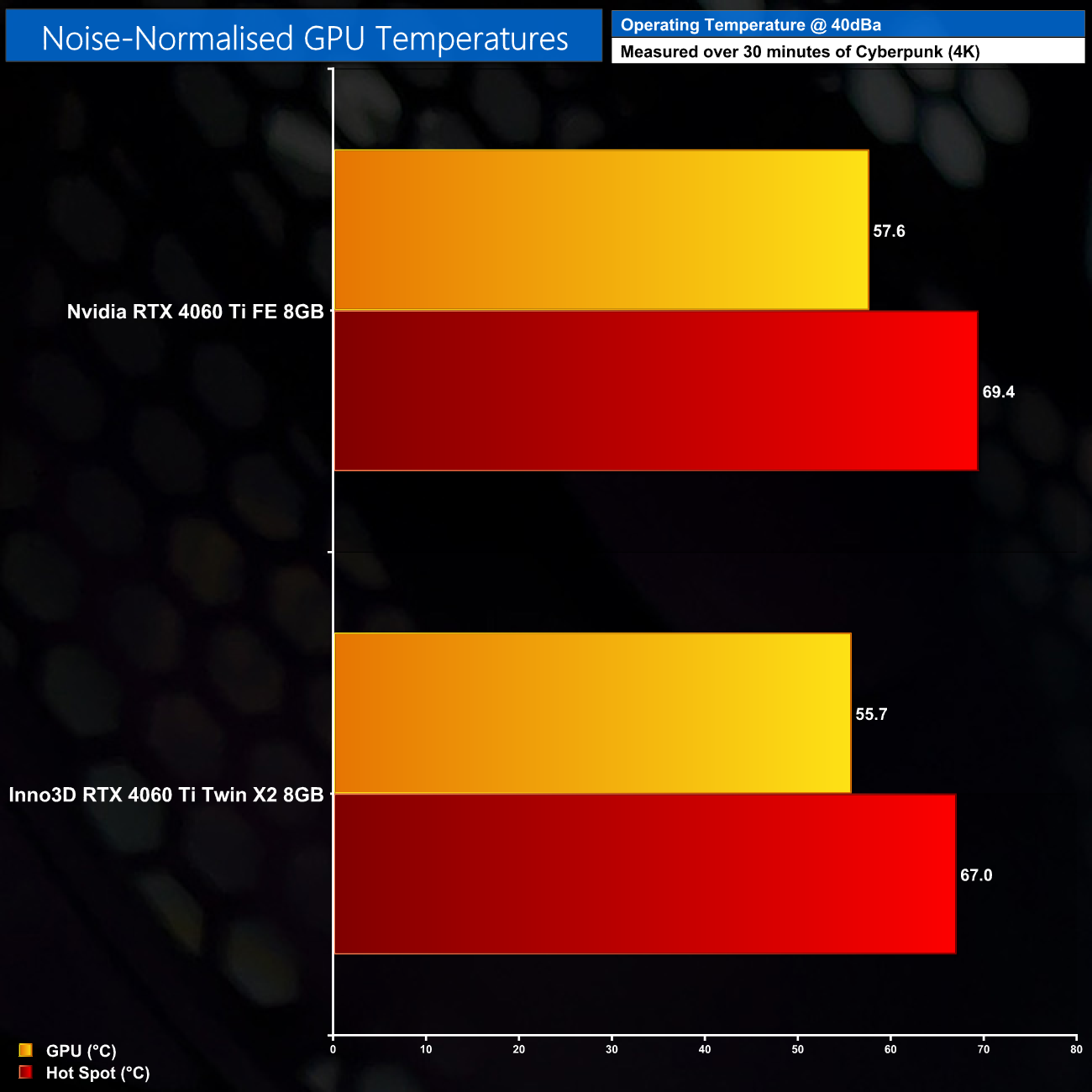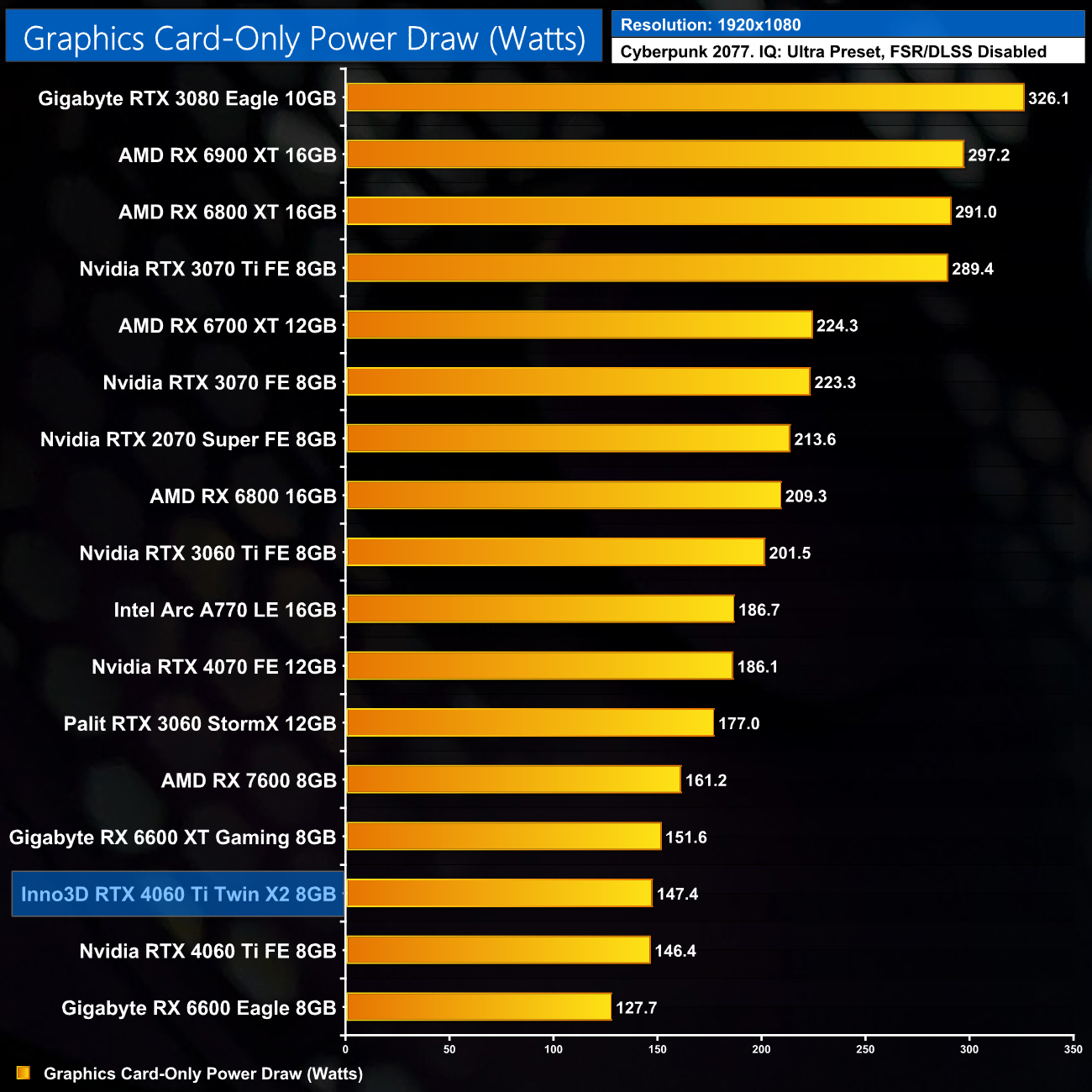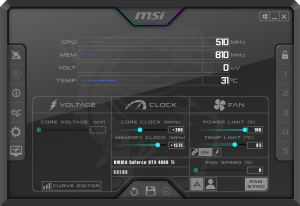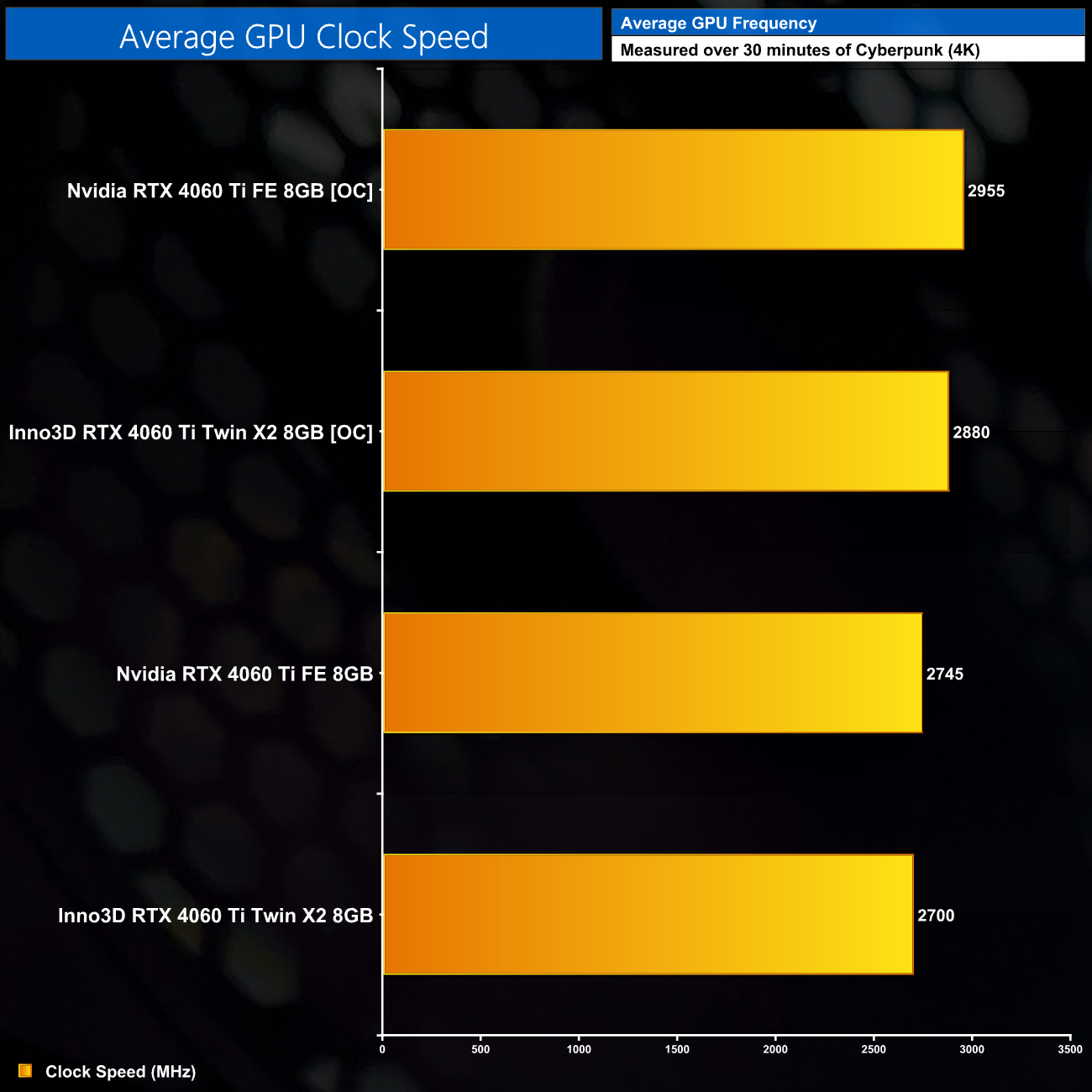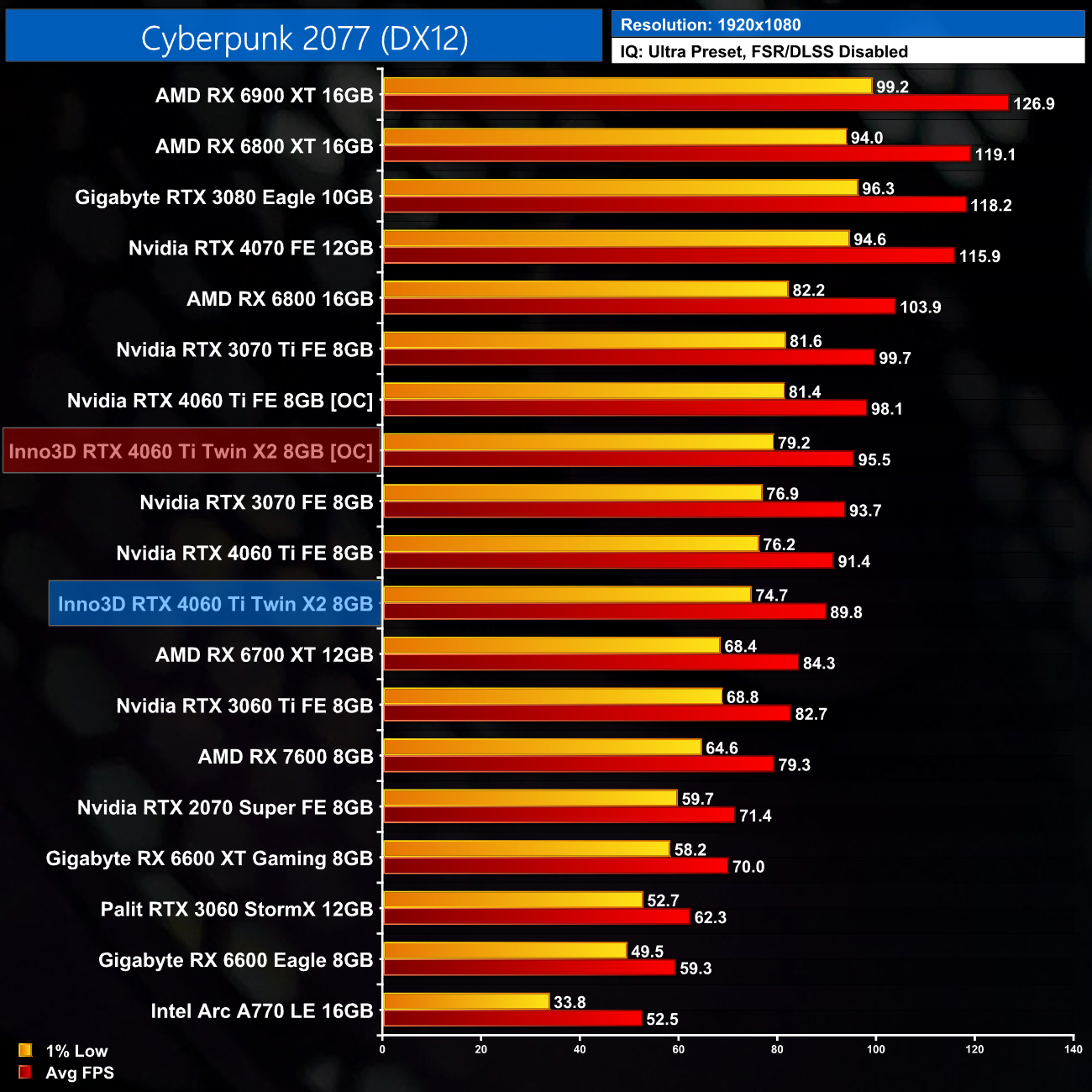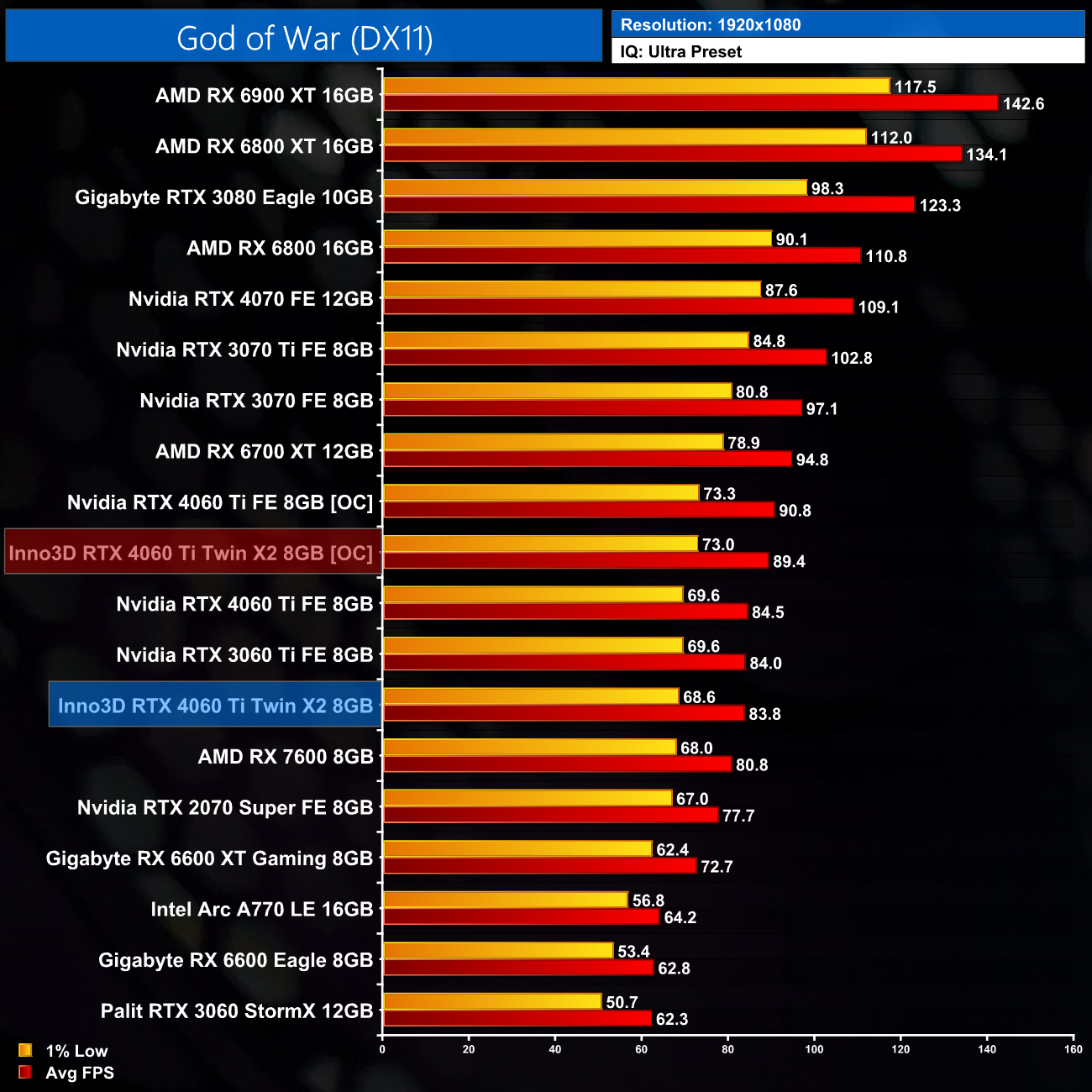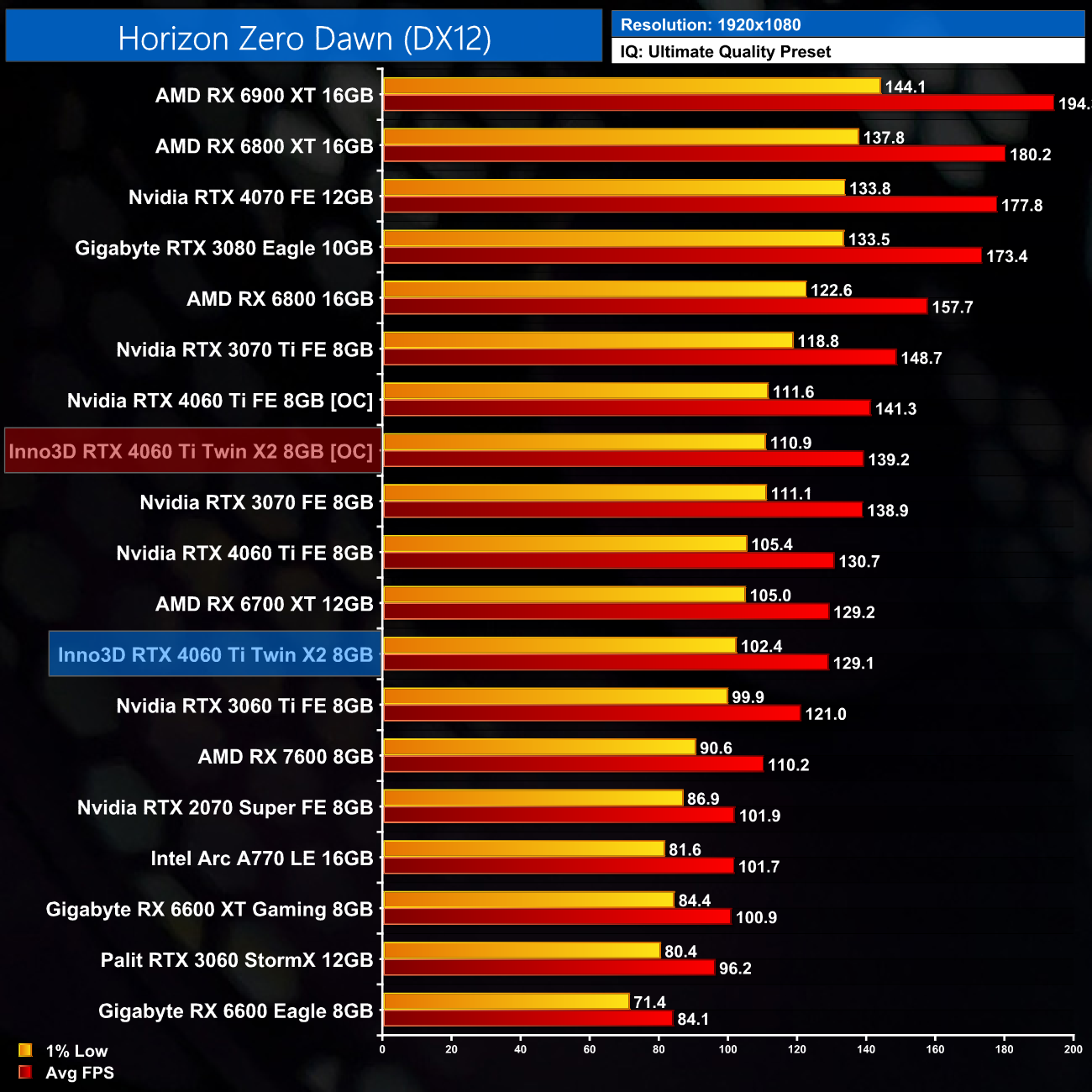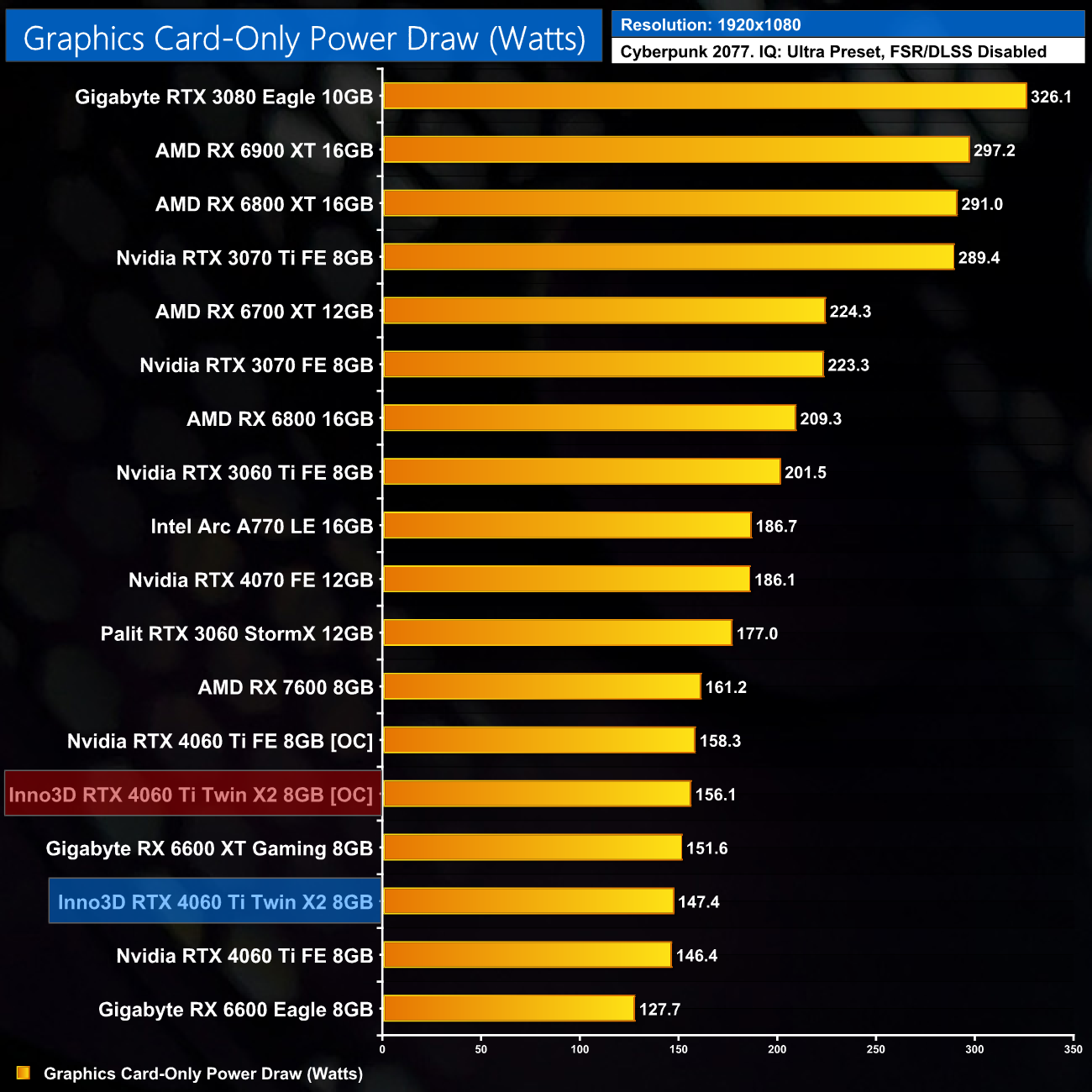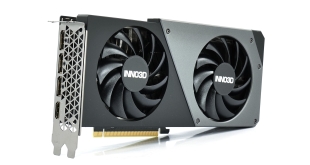
In for review today is the Inno3D RTX 4060 Ti Twin X2. Built to hit the £389 MSRP, this card offers a compact design, dual-fan cooler and metal backplate. It's certainly nothing fancy and doesn't even come factory overclocked, but if you're looking for a simple card that just works – with no faffing around with RGB lighting or multiple BIOS modes – could the Twin X2 be one to consider?
It's safe to say we were less than positive with our RTX 4060 Ti in our day 1 review, so it will be interesting to see if the Inno3D RTX 4060 Ti Twin X2 can change our views. Currently up for pre-order at £389.99 from OCUK, it is at least one of the most affordable partner cards, and you're not paying a price premium over the £389 MSRP.
But with the Founders Edition in stock at the same price, how will the Twin X2 compare in terms of gaming performance, thermals and noise levels? We find out today.
| RTX 4090 | RTX 4080 | RTX 4070 Ti | RTX 4070 | RTX 4060 Ti | RTX 3060 Ti | |
| Process | TSMC N4 | TSMC N4 | TSMC N4 | TSMC N4 | TSMC N4 | Samsung 8N |
| SMs | 128 | 76 | 60 | 46 | 34 | 38 |
| CUDA Cores | 16384 | 9728 | 7680 | 5888 | 4352 | 4864 |
| Tensor Cores | 512 | 304 | 240 | 184 | 136 | 152 |
| RT Cores | 128 | 76 | 60 | 46 | 34 | 38 |
| Texture Units | 512 | 304 | 240 | 184 | 136 | 152 |
| ROPs | 176 | 112 | 80 | 64 | 48 | 80 |
| GPU Boost Clock | 2520 MHz | 2505 MHz | 2610 MHz | 2475 MHz | 2535 MHz | 1665 MHz |
| Memory Data Rate | 21 Gbps | 22.4 Gbps | 21 Gbps | 21 Gbps | 18 Gbps | 14 Gbps |
| L2 Cache | 73728 KB | 65536 KB | 49152 KB | 36864 KB | 32768 KB | 4096 KB |
| Total Video Memory | 24GB GDDR6X | 16GB GDDR6X | 12GB GDDR6X | 12GB GDDR6X | 8GB GDDR6 | 8GB GDDR6 |
| Memory Interface | 384-bit | 256-bit | 192-bit | 192-bit | 128-bit | 256-bit |
| Memory Bandwidth | 1008 GB/Sec | 716.8 GB/Sec | 504 GB/Sec | 504 GB/Sec | 288 GB/Sec | 448 GB/Sec |
| TGP | 450W | 320W | 285W | 200W | 160W | 200W |
First, for a quick spec recap. The RTX 4060 Ti marks the first appearance of the AD106 silicon in the desktop space, a tiny die measuring just 190mm2. The fundamental building blocks are still the same of course, with the RTX 4060 Ti offering a total of 34 Streaming Multiprocessors (SMs), each housing 128 CUDA Cores, for a total of 4352. We also find 34 RT cores, 136 Tensor cores, 136 Texture Units, and 48 ROPs.
TSMC's N4 node has Nvidia cranking up the clock speed significantly this generation, with the RTX 4060 Ti sporting a 2535MHz rated boost clock. That's the highest clock speed on a desktop Ada GPU so far, and we would expect GPU Boost to push things further still. Inno3D has not factory overclocked the Twin X2.
The memory configuration is another area where AD106 has been cut-back significantly. The memory interface has been reduced to 128-bit, and even with 8GB GDDR6 running at 18Gbps, that brings total memory bandwidth down to 288 GB/s, lower than even the RTX 3060. That said, there has been a substantial upgrade to the L2 cache with the Ada architecture, with the RTX 4060 Ti now offering 32MB, compared to just 4MB for GA104.
It's also worth noting that the PCIe bus has also been reduced, with the 4060 Ti offering a Gen4 x8 interface, as opposed to Gen4 x16 connectors on the rest of the 40-series.
Considering these cut-backs, power draw is naturally lower than the RTX 4070, with the 4060 Ti boasting a 160W TGP. Inno3D has not increased the power target either, nor can it be increased above the 160W figure when manually overclocking.
The Inno3D RTX 4060 Ti Twin X2 ships in a mostly black box, but with a large Twin X2 logo – along with some sort of robotic creature – visible on the front. On the back, Inno3D highlights various key features of the card and cooler design.
The only included accessories are a small power supply guide, as well as a separate quick start guide.
Looking at the card itself, Inno3D is making use of a two-tone appearance for the shroud – one half is matte black, and the other half is a brushed grey finish. It's made entirely from plastic, so the brushed section isn't made of metal, but it feels solid enough in the hand. Then again, the Founders Edition is undeniably a much more premium looking card available at the same price, so it's something to consider.
In terms of those two fans, Inno3D is using what it calls ‘scythe' fan blades, with a total of 11 per fan. Each fan measures 88mm in diameter.
As for dimensions of the Twin X2, it's pretty compact at 250 x 118 x 42mm. For reference, the Founders Edition measures 242mm x 112mm – so both cards are traditional dual-slot models, and while the Twin X2 is a hair longer, the difference is not large. It does weigh in at 761g, compared to 1032g for the Founders, making it 26% lighter.
The front side of the card is home to the Inno3D and GeForce RTX logos, but it's worth noting there is no lighting of any kind on the Twin X2.
Meanwhile, we can see a full length metal backplate is utilised, with a cut-out behind the GPU core and several cut-outs towards the end of the card to allow air to pass directly through the heatsink and out into the chassis.
Display outputs are standard, consisting of 3x DisplayPort 1.4 and 1x HDMI 2.1.
We can also note that Inno3D – like most partners – has opted to fit the card with a single 8-pin power connector, so no adapters or new 12VHPWR cables required.
Moving on to look at the PCB, the first thing to note is how compact it is, as the PCB is barely longer than the PCIe x16 slot! Inno3D has opted for a five-phase VRM for the GPU, using 55 Amp Alpha & Omega AOZ5311NQI MOSFETs, controlled by a UPI UP9512R. The memory is a single-phase, using one UPI Semi QN3103 and two QN3107 MOSFETs, utilising a 7212 controller.
The cooler meanwhile looks more than adequate for this level of heat from the AD106 GPU. A reasonably dense aluminium finstack is deployed, connected by three 6mm heatpipes. The GPU and memory modules contact with a plated copper base, while the GPU MOSFETs are cooled by a separate base plate.
No thermal pads are positioned on the underside of the backplate.
Driver Notes
- All AMD GPUs (except RX 7600) were benchmarked with the Adrenalin 23.3.2 driver.
- All Nvidia GPUs (except RTX 4070) were benchmarked with the 531.41 driver.
- All Intel GPUs were benchmarked with the 101.4314 driver.
- RTX 4070 was benchmarked with the 531.42 driver supplied to press.
- RTX 4060 Ti was benchmarked with the 531.93 driver supplied to press.
- RX 7600 was benchmarked with the driver supplied to press.
Test System:
We test using a custom built system from PCSpecialist, based on Intel’s Rocket Lake platform. You can read more about this system HERE and configure your own PCSpecialist system HERE.
| CPU |
Intel Core i9-13900KS
|
| Motherboard |
Gigabyte Z790 Gaming X AX
|
| Memory |
32GB (2x16GB) Corsair Dominator Platinum RGB DDR5 6000MHz
|
| Graphics Card |
Varies
|
| SSD |
4TB Seagate Firecuda 530 Gen 4 PCIe NVMe
|
| Chassis | Corsair 5000D Airflow Tempered Glass Gaming Case |
| CPU Cooler |
Corsair iCUE H150i Elite RGB High Performance CPU Cooler
|
| Power Supply |
Corsair 1600W Pro Series Titanium AX1600i Digital Modular PSU
|
| Operating System |
Windows 11 22H2
|
| Monitor |
MSI Optix MPG321UR-QD
|
| Resizable BAR |
Enabled for all supported GPUs
|
Comparison Graphics Cards List
- AMD RX 7900 XT 20GB
- AMD RX 6900 XT 16GB
- AMD RX 6800 XT 16GB
- AMD RX 6800 16GB
- AMD RX 6700 XT 12GB
- Gigabyte RX 6600 XT Gaming 8GB
- Gigabyte RX 6600 Eagle 8GB
- Intel Arc A770 LE 16GB
- Gigabyte RTX 4070 Ti Gaming 12GB
- Nvidia RTX 4070 Founders Edition 12GB
- Nvidia RTX 4060 Ti Founders Edition 8GB
- Gigabyte RTX 3090 Ti Gaming 24GB
- Gigabyte RTX 3090 Eagle 24GB
- Gigabyte RTX 3080 Eagle 10GB
- Nvidia RTX 3070 Ti FE 8GB
- Nvidia RTX 3070 FE 8GB
- Nvidia RTX 3060 Ti FE 8GB
- Palit RTX 3060 StormX 12GB
- Nvidia RTX 2070 Super FE 8GB
All cards were tested at reference specifications.
Software and Games List
- 3DMark Fire Strike & Fire Strike Ultra (DX11 Synthetic)
- 3DMark Time Spy (DX12 Synthetic)
- 3DMark DirectX Raytracing feature test (DXR Synthetic)
- Assassin's Creed Valhalla (DX12)
- Control (DXR)
- Cyberpunk 2077 (DX12)
- Days Gone (DX11)
- Dying Light 2 (DX11)
- F1 22 (DXR)
- God of War (DX11)
- Hitman 3 (DXR)
- Horizon Zero Dawn (DX12)
- Marvel's Spider-Man Remastered (DX12)
- Metro Exodus Enhanced Edition (DXR)
- A Plague Tale: Requiem (DX12)
- Red Dead Redemption 2 (DX12)
- Resident Evil Village (DX12)
- Total War: Warhammer III (DX11)
- Uncharted 4: A Thief's End (DX12)
We run each benchmark/game three times, and present mean averages in our graphs. We use FrameView to measure average frame rates as well as 1% low values across our three runs.
3DMark Time Spy is a DirectX 12 benchmark test for Windows 10 gaming PCs. Time Spy is one of the first DirectX 12 apps to be built the right way from the ground up to fully realize the performance gains that the new API offers. With its pure DirectX 12 engine, which supports new API features like asynchronous compute, explicit multi-adapter, and multi-threading, Time Spy is the ideal test for benchmarking the latest graphics cards. (UL).
An initial test of 3DMark Time Spy sees the Twin X2 a mere 200 or-so points behind the Nvidia Founders Edition – it's essentially within margin of error here.
Here we test five games, all at 1920×1080 resolution using maximum image quality settings.
We don't test as many games in our AIB card reviews as we would in our day 1 launch articles for reasons that should be pretty clear from viewing the above charts – the real-world gaming difference between two of the same GPUs is essentially nil. Our figures do show incredibly minor differences, with the Inno3D 1-2% behind the Founders Edition, but that's hardly even worth mentioning. In the real world, there'd be no telling these two cards apart based on gaming performance.
Here we present the average clock speed for each graphics card while running Cyberpunk 2077 for 30 minutes. We use GPU-Z to record the GPU core frequency during gameplay. We calculate the average core frequency during the 30 minute run to present here.
Interestingly, despite both the Twin X2 and Nvidia Founders Edition sharing the same 2535MHz rated boost clock, we did observe the Twin X2 running a fraction slower in our stress test. Over the thirty minute run, it averaged 2700MHz, compared to 2745MHz for the Nvidia FE.
We can also note that the Twin X2 ran at 2700MHz the entire time, indicating it was not power limited at all – you can see this by looking at the perfectly straight line on the above chart, it simply locked in at 2700MHz and did not budge.
For our temperature testing, we measure the peak GPU core temperature under load. A reading under load comes from running Cyberpunk 2077 for 30 minutes.
As for thermals, in the out of the box state, there is very little to split between the Twin X2 and the Founders Edition. The Inno3D came in with a peak of 61.4C on the GPU, and 74.1C on the hot spot, making it roughly 1C cooler than Nvidia's own design. There's very little in it though, so let's see if noise levels will separate these two cards…
We take our noise measurements with the sound meter positioned 1 foot from the graphics card. I measured the noise floor to be 32 dBA, thus anything above this level can be attributed to the graphics cards. The power supply is passive for the entire power output range we tested all graphics cards in, while all CPU and system fans were disabled. A reading under load comes from running Cyberpunk 2077 for 30 minutes for 30 minutes.
Similarly, noise levels measured in at the same 34dBa output as we saw from the Founders Edition. In my testing, this was with the Twin X2 fans spinning at just 35%, or 1320rpm, making it almost inaudible under load. There was no audible coil whine on my sample either.
Following on from our stock thermal and acoustic testing, here we re-test the operating temperature of the GPU, but with noise levels normalised to 40dBa. This allows us to measure the efficiency of the overall cooling solution as varying noise levels as a result of more aggressive fan curves are no longer a factor.
We had to increase fan speed up to 63%, or 1950rpm, to hit 40dBa of noise, at which point GPU thermals peaked at just 55.7C, with the hot spot at 67C. Both metrics are about 2C cooler than Nvidia's Founders Edition, so the Twin X2 is the more efficient cooler, but there's not much in it.
We use Nvidia PCAT to measure power draw of the graphics card only, with readings from both the PCIe slot and the PCIe power cables combined into a single figure. We use Cyberpunk 2077 (4K) for this testing.
Power draw of the graphics card is no surprise, with the Twin X2 coming within 1W of the Founders Edition. After all, both share the same 160W limit and clock almost identically, so we'd expect very similar power draw and that's certainly what we get here.
For our manual overclocking tests, we used MSI Afterburner. Our best results are as below.
Overclocking the RTX 4060 Ti Twin X2 is pretty straight forward. Inno3D has locked the power limit at 100%, so we are simply unable to increase this, but we were still able to add 200MHz to the GPU and 1575MHz to the memory.
This brought average operating clock speeds up to 2880MHz, or a real-world increase of 180MHz compared to stock.
This overclock netted us performance gains in the region of 6-8%, which is pretty much what we'd expect nowadays. The Founders Edition did clock that tiny bit higher when pushed to its limit, but the difference is barely 1-2FPS.
Power draw did rise as a result of this overclock, but only by 9 Watts, and even then we are still under the 160W power limit of the RTX 4060 Ti so it's hardly a concern.
In what will likely be our sole RTX 4060 Ti partner card review, today we have assessed the Inno3D RTX 4060 Ti Twin X2, an MSRP card that is currently listed for pre-order at Overclockers UK for £389.99.
As AIB cards go, the Twin X2 is a decent offering, and were it any other GPU, we'd give it a solid recommendation. Gaming performance is essentially identical to the Founders Edition, as are out of the box thermals and noise levels. When testing thermal performance with noise normalised at 40dBa, we even saw a small win for the Twin X2, as it ran about 2C cooler than the Founders Edition.
In terms of the card itself – forgetting the fact that this is an RTX 4060 Ti for now – the only real problem I have with it is that the design is perhaps slightly bland, though of course that's just my personal opinion. It's undoubtedly less well-built than the Founders Edition however, with a plastic shroud compared to the FE's premium aluminium body, and with both cards currently retailing at the same price – with so little else to split between these two cards – that could be enough to tip you towards the Founders.
The main reason we can't be more enthusiastic about this partner card however, is that the underlying GPU is just not something we can recommend. We won't rehash all the points here, but as you've already seen from our day 1 RTX 4060 Ti review, we believe this GPU is fundamentally flawed for several reasons, including the 8GB frame buffer and incredibly lacklustre performance increase versus the previous generation.
Of course, that's hardly Inno3D's fault, and in truth they've built an effective cooler for the GPU they were given. It's just a shame we can't speak more highly of it due to the lacklustre AD106 silicon it houses.
The Inno3D RTX 4060 Ti Twin X2 is up for pre-order at Overclockers UK for £389.99 HERE.
Pros
- Very good thermal performance out of the box.
- Whisper quiet.
- Slightly more effective cooling than the Founders Edition when noise-normalised.
- Overclocked reasonably well.
Cons
- It's still an RTX 4060 Ti – a product we just can't recommend.
- Slightly bland appearance.
- Founders Edition has a much more premium build at the same price.
KitGuru says: The Twin X2 is a decent AIB card, but ultimately we can't recommend anyone buy an RTX 4060 Ti right now.
 KitGuru KitGuru.net – Tech News | Hardware News | Hardware Reviews | IOS | Mobile | Gaming | Graphics Cards
KitGuru KitGuru.net – Tech News | Hardware News | Hardware Reviews | IOS | Mobile | Gaming | Graphics Cards


